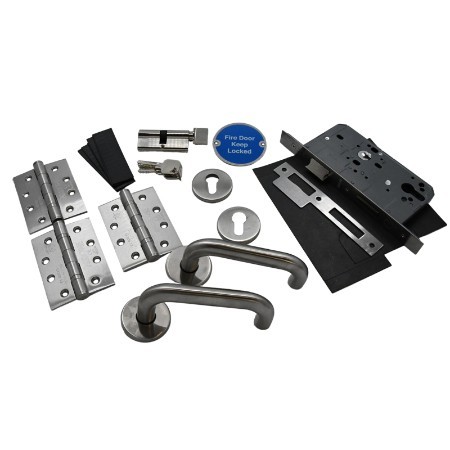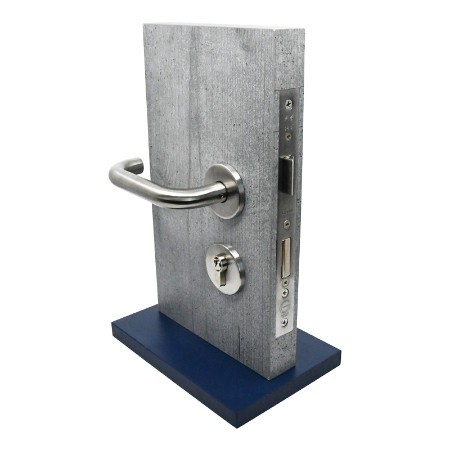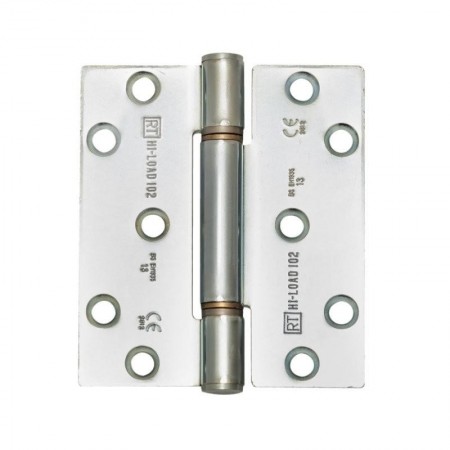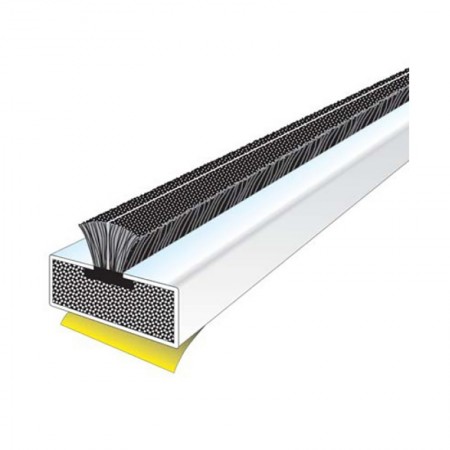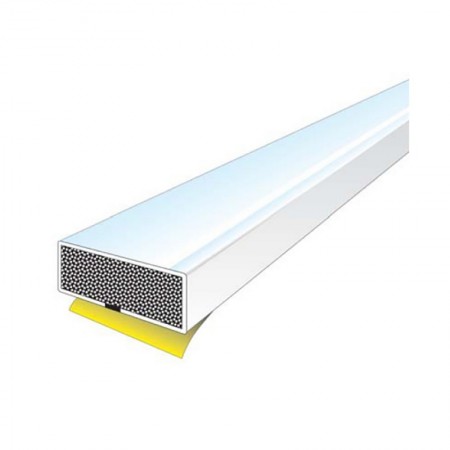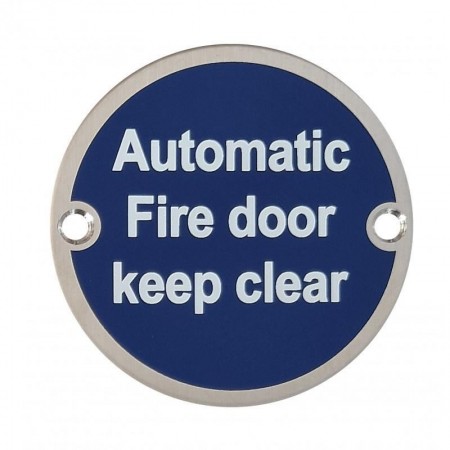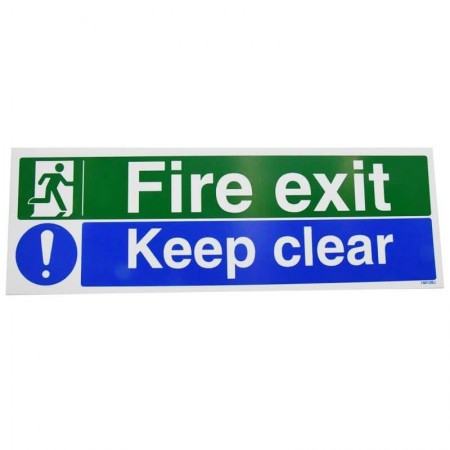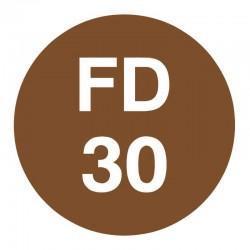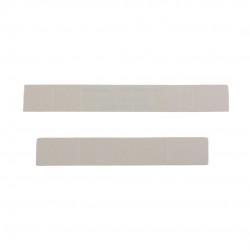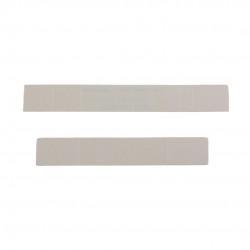Fire Door Ironmongery
If you have a fire door, you will need fire door ironmongery. Specifying the right ironmongery and door hardware is crucial to ensure that the fire rating of a door is maintained and, for the safety of the building’s occupants. The ironmongery in this section of the website is specifically for use on fire doors; the products are CE Marked and Certifire approved and comply with relevant British Standards.
BS EN 1634 Standard
BS EN 1634 is a European fire test standard for all fire door CE Marked ironmongery products. Anything CE marked must also Fire Doors in the UK are typically tested with just three fire rated products: 3 hinges, a door closer and a lock or latch. The bolt in a lock is wired back so that this does not contribute to holding the door closed. This then allows for the door manufacturer to be able to test two key points at the same time:
- The fire rating performance of the door itself without reliance on the lock or latch.
- Locks made of similar materials with the same dimensions can be fitted without affecting the integrity and therefore fire rating of the door.
A fire door must prove that it can withstand a fire attack for a specified amount of time, in order to successfully achieve its fire rating. This means that hot gasses and flames are not to pass through for the duration of a fire test. E.g. FD30 doors should have a 30 minute fire resistance and are tested for 36 minutes, FD60 Doors should have a 60 minute fire resistance and are tested for 67 minutes. This is known as Fire Door Integrity.
Fire Door Integrity does not include the passage of smoke and at the beginning of a fire test, smoke is pushed through the gaps between the door and frame and the meeting styles on a pair of double doors. Any intumescent that is fitted to these doors then expands and fills the gaps to reduce the passage of smoke through the door to 0 until the end of the expected fire rating where the door warps and burns completely.
Fire Rated Hinges
Fire doors should be fitted with 3no. 102mm hinges that are CE marked under Fire Regulations. Fitting 3 hinges will also help stop the door from warping – for extra tall doors over 2200mm, four hinges may be used to prevent this. Occasionally 2 hinges may be used but only with supporting fire test evidence. Fire door hinges must remain attached to the door during a fire test, even if the timber around them is charred. Some steel and Brass hinges are acceptable for use on FD30 30-minute fire doors whilst only steel hinges should be use on FD60 60-minute fire doors. Under BS EN1935:2002, any hinges fitted to a fire door, must be able to achieve the appropriate fire rating. They must also not impede any door closers that may be fitted to the doors and overcome any seals and resistance from latches. Intumescent hinge pads should be used with all hinges on fire doors, even if they are CE Marked, or full compliance with fire ratings.
Fire Rated Door Closers
All door closers fitted to a fire door, whether concealed or overhead, must be CE Marked and suitable for the fire rating of a door. You must not install any ironmongery that has a fire test rating lower than that of the door. For example, if you have a 60-minute fire rated door, you cannot install anything that has a lower fire rating like products with a 30-minute fire rating. You can, however, install a 60-minute fire rated product on a 30-minute fire rated door.
Door Closers should be performance tested to EN1534 and Fire Tested to EN1634 in order to be CE marked. They should also be a minimum of a power size 3 (EN3) when fitted to a fire door.
If a door is to be held open, then an electromagnetic door closer linked up to the fire alarm interface should be used.
Digital Locks
There is no performance test to which Digital Locks should comply, however fire rated digital locks should be supplied with appropriate intumescent and be fire tested to EN 1634 and EN 476.
Locks & Latches Locks
Any lock or latch installed on a fire door must be CE Marked and tested to BS EN 12209. Fire Rated mortice locks and latches can be installed with intumescent jackets and any cut made into the door to accommodate them must be minimal.
Fire Rated Intumescent
Intumescent Seals have an important job of expanding to fill gaps around the edge of the doors to prevent the spread of smoke and fire. It contributes to the fire rating of a door as it slows down the ability of flames to pass through the door. When a fire door and seals are fitted correctly, any gaps around the top and sides should be less than 4mm thick – the seals will expand to fill these in the event of a fire.
Any hinges and morticed locks and latches should be installed with appropriate intumescent sheets or pads. These act as a barrier between the product and the door to ensure that heat transfer is delayed. Always check the fire test certificates to ensure full compliance with any given fire rating.
Fire Rated Accessories & Signage
Accessories on Fire Doors must not affect the integrity of a fire door. There are products like door viewers for example, that have been fire tested with intumescent that are appropriate for use on such doors.
Signage for fire door is mandatory and falls under BS 5499-5:2002 Approved Document B. All fire doors must display signs that either read “Fire Door Keep Locked” or “Fire Door Keep Shut” depending on the function of the door. There are no performance standards for signage, and they should be face fixed to the fire door.
Fire Rated Lever Handles
Fire Rated lever handles should conform to BS EN1906 – the British Standard for Door Furniture. This standard covers all door furniture with backplates or roses. There does not necessarily need to be a CE marking but the handle set should have been put through fire testing and given a Grade 3 for durability and a Grade 1 for Fire Rating.
Fire Rated Pull Handles
Pull Handles, although are never CE Marked, should be tested under BS 476, which is the British fire test standard on building materials and building structures. BS EN476 grades the level of resistance that an ironmongery product has, using a class system. During this test, products are set alight with a pilot flame and then extinguished after 1 minute. The material of the product might start to burn and the test ends when either the flame front reaches a 825mm reference point or after 10 minutes – whichever comes first. The flame is then classified according to the time that the flame crosses certain reference points, the extent of flame spread during the first 1.5minutes of the test, the maximum distance the flame spread (10 minute/825mm limit) and the time taken for the flame to spread.
Intumescent Letterboxes
If you must install a letterbox on a fire door, you must only use an intumescent letterbox so as not to affect the integrity of the fire door.

